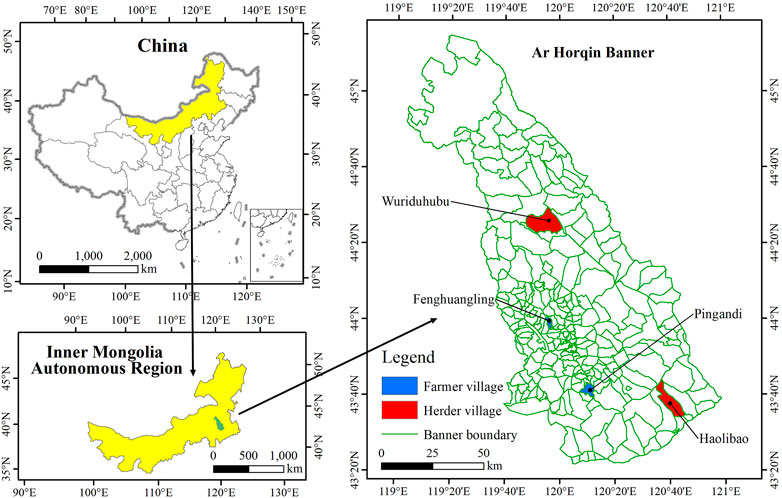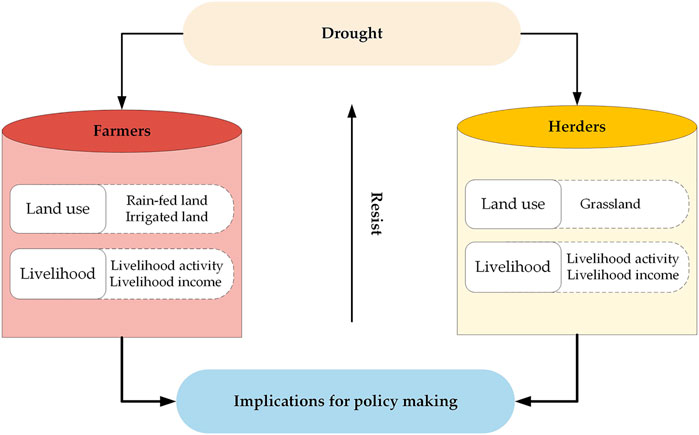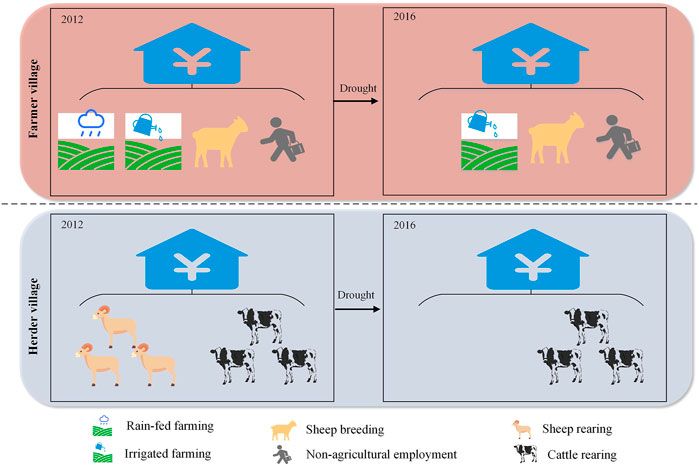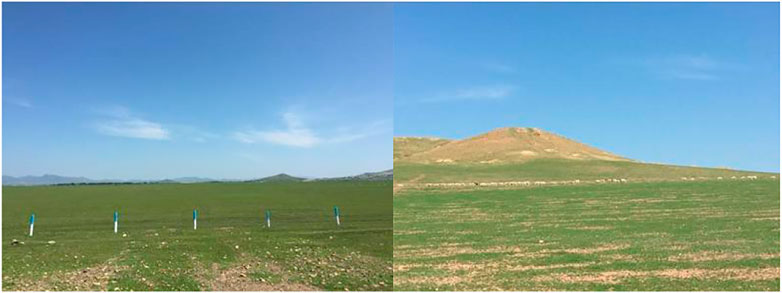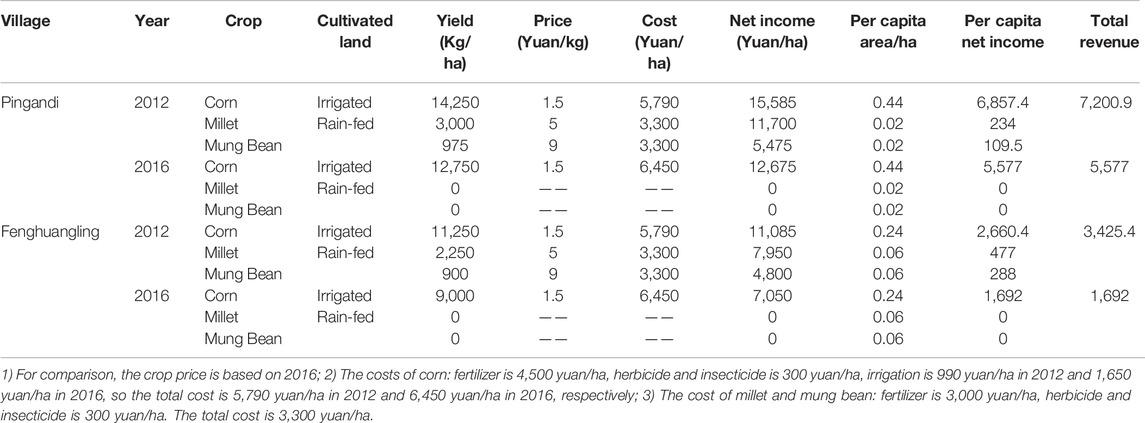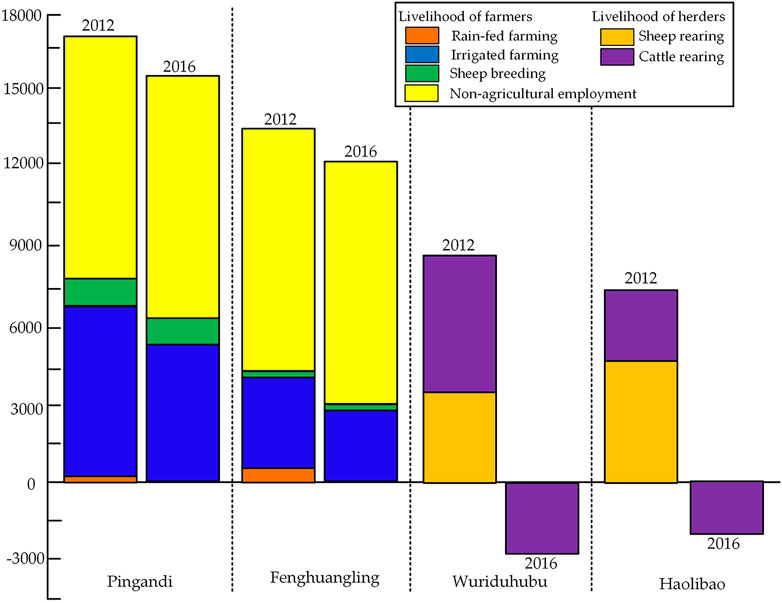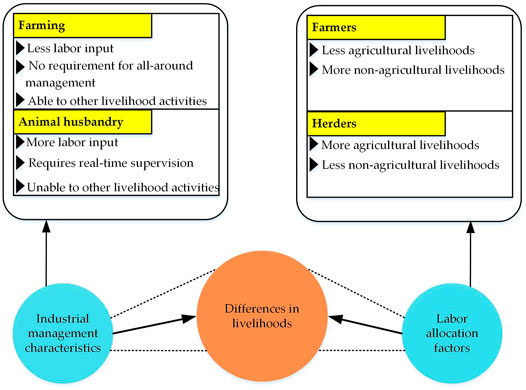- 1School of Environmental Science and Engineering, Tiangong University, Tianjin, China
- 2School of Economics and Management, Tiangong University, Tianjin, China
- 3School of Public Administration of Policy, Shandong University of Finance and economics, Jinan, China
- 4Land Reserve Center of Jinan, Jinan, China
- 5School of Natural Resource, Faculty of Geographical Science, Beijing Normal University, Beijing, China
- 6Northwest Land and Resources Research Center, Shaanxi Normal University, Xi’an, China
The agro-pastoral ecotone is an ecologically fragile region where drought is the main factor influencing land use and livelihoods. In this paper, we took two farmer villages and two herder villages in Ar Horqin Banner, located in the agro-pastoral ecotone of northwestern China, as the research areas, and where we conducted participatory rural appraisal and questionnaire survey to analyze the responses of land-use changes to drought and its disparate impact on the livelihoods of farmers and herders. Results show that: 1) Under drought, farmers tended to abandon rain-fed land, and herders tended to abandon grassland. 2) The livelihood activities of farmers were more stable than those of herders under drought. Farmers abandoned rain-fed farming, and herders just retained cattle rearing. The per capita net income of each farmer in Pingandi and Fenghuangling in the drought year of 2016 was only 9.27% and 12.52% lower than those in 2012, respectively, which was 132.88% and 128.25% lower than those in 2012 of each herder in Wuriduhubu and Haolibao. 3) Diversified livelihoods, especially non-agricultural ones, are the key to ensuring the sustainable livelihoods of farmers and herders. It is an effective way for farmers to encourage more labor force to emigrate to non-agricultural sectors. Regarding herders, it is urgent to develop artificial pastures and animal products processing industry with the support of government.
1 Introduction
The agro-pastoral ecotone in northwestern China, a transitional zone between the western desert and the eastern agricultural areas, is an ecologically fragile region with drought as the main stressor on ecology (Meng et al., 2015; Liu et al., 2020). The coexistence of farming and animal husbandry is the main mode of agricultural production, and the inlay of cultivated land within grassland is the main landscape (Yang and Wang, 2019; Liu, 2021). The ecological equilibrium has been broken by the increased intensity of land uses and drought episodes, which aggravates the fragility of ecosystems (Wang F. et al., 2012; Han et al., 2018). Coping with the threat of drought is a major challenge to sustainable development in the agro-pastoral ecotone (Tang et al., 2012; Lei et al., 2016; Martin et al., 2016; Zhao et al., 2019).
In the area, previous research has focused on the temporal and spatial changes of cultivated land or grassland (Zarafshani et al., 2012; Tesfa and Mekuriaw, 2014; Yu, 2016). It is an inefficient approach for determining differences in the changes of the two land use types as well as the socioeconomic effects of these changes by not putting both land use types into a research framework (Wang et al., 2020; Liu et al., 2021; Tao et al., 2021). The main reasons for land-use changes are eco-environmental factors and effects related to climate change and human activities (Ma et al., 2020; Li et al., 2021; Xue et al., 2021). Studies have focused on the livelihoods of rural residents under climate change and their coping strategies (Liu et al., 2012; Song et al., 2015; Wu et al., 2017). The livelihood vulnerability of farmers under climate change declines as their livelihood diversification increases (Wang J. et al., 2012; Chen et al., 2014). Diversified livelihoods can mitigate the impact of climate change on the quality of life of farmers (Paavola, 2008; Liao et al., 2015). In contrast, herders rely on animal husbandry, and their livelihoods severely affected by the degradation of the quality of grassland (Mogotsi et al., 2012; Zhang et al., 2012; Majekodunmi et al., 2014; Beyene, 2016; Tan et al., 2018). Hence, the stability of livelihoods of farmers and herders is different under drought (Roncoli et al., 2001; Yan et al., 2010; Liu et al., 2011). Despite this disparity, current research has mostly focused on the impact of drought on the livelihoods of farmers and herders in the agro-pastoral ecotone of China, collectively, which is not a robust approach when seeking to compare and contrast the different challenges these two groups of rural residents face under ecological stress.
Research has shown that the agro-pastoral ecotone of China is subjected to an increasing trend of interannual drought, and its degree has been aggravated in the past 55 years and is expected to be further aggravated (Guo et al., 2021). Based on the above arguments, we investigated two farmer villages and two herder villages in agro-pastoral ecotone of Ar Horqin Banner (AHB, Banner equivalent to County) with the intention of determining the socioeconomic challenges faced by its farmers and herders under drought. The goals are: 1) To investigate the main land resources of farmers and herders and their changes; 2) to outline and understand the differences of livelihoods between farmers and herders and the challenges they face; and 3) to suggest policies which would promote the improvement of the livelihoods of farmers and herders to resist and mitigate negative impacts of drought.
2 Materials and Methods
2.1 Study Area
The AHB is located in the Inner Mongolia Autonomous Region of northwestern China (Figure 1), characterized by a mid-latitude, temperate, semi-arid, continental monsoon climate. The geographical coordinates which bound the domain are 119°02′–121°01′E, 43°21′–45°24′N and the annual average rainfall is only 320–400 mm. The AHB is endemic to competition between farming and animal husbandry. The southwest of AHB is farming areas while others are pastoral areas. Grassland and cultivated land are the most important land-use types, covering 777,522 and 138,599 ha in 2016, respectively, accounting for 58.72% and 10.47% of the total area. In terms of being seriously affected than other villages, the villages of Pingandi, Fenghuangling, Wuriduhubu, and Haolibao were selected. The farmer villages of Pingandi and Fenghuangling have residents who are farmers. The herder villages of Wuriduhubu and Haolibao, called “gacha” in Mongolian, have residents who are herders. The cultivated lands of farmers include rain-fed land and irrigated land, and most crops are ripe once a year. The irrigation period is mainly from May to August, while the rain-fed land is completely dependent on precipitation. In addition, farmers engage in non-agricultural employment. For herders, grassland is the main land resource. They engage in animal husbandry, mainly sheep and cattle rearing. The agricultural livelihoods of rural residents in the study areas mainly rely on natural conditions, especially precipitation, causing drought to become the main factor affecting land uses and livelihoods. The AHB experienced a four-year drought from 2013 to 2016, which significantly impacted land uses, flora coverage, and consequently the livelihoods of farmers and herders.
2.2 Data Acquisition and Processing
From 2012 to 2016, the annual precipitation of AHB represented a decreasing trend, with 561.1, 307.0, 313.3, 212.2, and 408.3 mm, respectively. Due to the continuously decreasing precipitation from 2012 to 2015, the degree of drought reached its peak in 2016. The methods of participatory rural appraisal and questionnaire survey were employed to investigate the land uses and livelihoods of both farmers and herders in 2012 (the non-drought year) and 2016 (the drought year). First, we conducted face-to-face interviews with village managers to acquire data that centered on land-use changes and the state of livelihoods of farmers and herders (Tables 1, 2). Second, with the intent of ensuring data acquisition effectiveness, 30 farmers in Pingandi and Fenghuangling, and 30 herders in Wuriduhubu and Haolibao were selected to conduct a closed questionnaire survey. The recovery rate is 100%. The data mainly included: 1) Individual information of farmers and herders; 2) types of land use of farmers and herders in 2012 and 2016, and their changes; 3) the livelihood activities and incomes of farmers and herders in 2012 and 2016, and their changes; and 4) the causes attributed to differences in livelihoods of farmers and herders. The survey was conducted in October 2016 by a five-member research team. The questionnaire data were then statistically analyzed using the SPSS software package.
2.3 Hypotheses
In the agro-pastoral ecotone, the livelihoods of farmers are more diverse than those of herders. Farmers are engaged in farming, as well as in non-agricultural sectors. Herders mainly rely on grassland to develop animal husbandry, which is the main income source for them. Under drought, the quality of rain-fed land and grassland is degraded. The impacts of drought-driven land-use changes on livelihoods (including livelihood activities and livelihood incomes) of farmers and herders are different due to different livelihood structures.
We take the losses in land resources and livelihoods from 2012 to 2016 as indicators to measure the stability of livelihoods of farmers and herders under drought. The research framework is shown in Figure 2.
3 Results
3.1 Land-Use Changes Induced by Drought
3.1.1 Rain-Fed Land was Abandoned by Farmers
Both rain-fed and irrigated land were the land resources in the farmer villages. The per capita area of cultivated land of each farmer was 0.48 ha and 0.36 ha in Pingandi and Fenghuangling, of which 0.44 and 0.24 ha was irrigated land, respectively. Therefore, irrigated land was the main land resource of farmers. This area is irrigated with groundwater and hardly threatened by drought due to the stable of group water pumping. As for rain-fed land, it is completely dependent on precipitation. Therefore, under drought conditions, this area suffered serious impact. The rain-fed land was abandoned in 2016 (Figure 3).
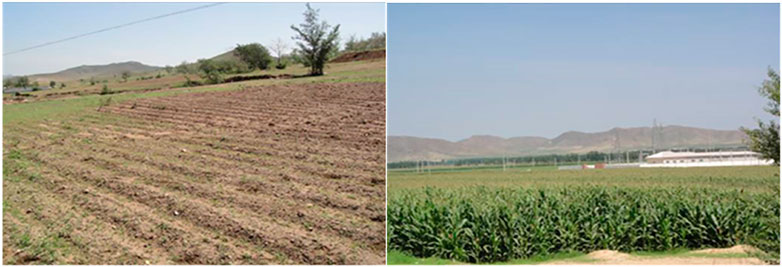
FIGURE 3. Rain-fed and irrigated land of Pingandi in August 2016 (the left is rain-fed abandoned land, the right is irrigated land).
3.1.2 Grassland was Abandoned by Herders
Grassland was the main land resource in the herder villages. The per capita area of grassland of each herder was 9.53 ha in Wuriduhubu, and 11.33 ha in Haolibao. The quality of grassland is dependent on precipitation. Due to the precipitation decreasing from 561.1 to 212.2 mm from 2012 to 2015, the water demand gap of the grassland reached its peak in 2016, and it was seriously degraded with the quality of grass insufficient for animal husbandry (Figure 4). Therefore, herders abandoned grassland in 2016.
3.2 Impacts on Livelihoods
3.2.1 The Livelihood Activities of Farmers Were More Diverse Than Those of Herders
In 2012, farming (irrigated and rain-fed), livestock breeding (raising sheep in captivity due to the grazing prohibition policies for farmers in the farming areas of AHB), and non-agricultural employment (non-local refers to those working out of the town, and local refers to those working within the town) were the main livelihood activities of farmers in the farmer villages (Figure 5). In 2016, rain-fed farming was abandoned. Unlike herders, sheep breeding in the farmer villages has not been affected because of the pattern of breeding (Figure 4). Therefore, the drought had little impact on their other livelihood activities.
In 2012, animal husbandry (sheep and cattle rearing) was the main livelihood activity of herders in the herder villages. In 2016, herders were forced to sell lambs and entrusted other herders to graze their ewes in those Banners influenced slightly by drought because of the degraded grassland quality and the associated decline in the carrying capacity. As a result, only cattle rearing was retained who raised mainly on forage and green stored corn. The livelihood activity of herders was seriously affected.
3.2.2 The Loss in Livelihood Incomes of Herders was Greater Than That of Farmers
Although livelihood incomes of farmers reduced in 2016, the change was slight. Farming and livestock breeding don’t require much labor time and their income proportion is relatively low. Farmers are inclined to engage in other livelihood activities to improve their livelihoods. Hence, non-agricultural employment accounts for a major proportion of farmers’ livelihood incomes (Tables 3, 4). In 2016, the loss in livelihood incomes was mainly attributed to rain-fed farming. The incomes of livestock breeding and non-agricultural employment were only slightly affected. Hence, the total per capita net income of each farmer in Pingandi and Fenghuangling was 15,889.28 yuan and 12,113.16 yuan, respectively, which was only 9.27% and 12.52% lower than those in 2012.
Herders hardly engage in other livelihood activities. The sheep and cattle rearing were the main sources of their livelihood incomes (Tables 5, 6). In 2016, the cost of sheep rearing was greatly increased, while the income was reduced (the selling price of a lamb decreased from 1,000 yuan to 400 yuan due to the poor quality of lambs). The per capita net income of sheep rearing of each herder in Wuriduhubu and Haolibao decreased by 159.84% and 170%, respectively. The cost of cattle rearing was much higher than in 2012, and there was almost no revenue from catle rearing. Hence, the total per capita net income of each herder was −2,920 yuan and −2,273 yuan, respectively. The livelihood incomes in Wuriduhubu and Haolibao in 2016 were lower than those in 2012 by 132.88% and 128.25%, respectively.
3.3 Livelihood Diversification is the Key to Ensure the Stability of Livelihoods
The livelihood activities and incomes of farmers are diverse. Besides farming and livestock breeding, non-agricultural livelihood accounted for a large proportion (Figure 6). Although farmers faced the double pressure of abandoning rain-fed farming and the increasing cost of irrigated farming, the net income from farming still remained higher than 7,050 yuan/ha, which was a relatively considerable sum. Moreover, the proportion of non-agricultural income accounted for 51.62% and 72.53% in Pangandi and Fenghuangling in 2012, and 56.9% and 82.91% in 2016, respectively. Farmers can rely on non-agricultural employment to ensuring the stability of livelihoods. Hence, the diversified livelihoods, especially non-agricultural ones enable farmers to resist the threat of drought.
The livelihood activity of herders is single-dimensional, and more vulnerable than that of farmers under drought. With the continuation of drought, the animal husbandry seriously declined, with the incomes the herders got barely covered their cost in 2016. This makes the livelihoods of herders fragile and unadaptable under drought. Furthermore, herders took out loans to maintain animal husbandry activities during the drought years. According to our survey, the average loan of a herder family was about 46,700 yuan and 54,500 yuan in 2016 in Wuriduhubu and Haolibao, respectively. Hence, it is impossible to compensate for the losses suffered in animal husbandry without other livelihood activities.
4 Discussion
4.1 Causes of the Differences in the Livelihoods of Farmers and Herders Induced by Drought
Farming is less time-consuming than that of animal husbandry (Figure 7). For instance, according to our survey, one ha of corn costs no more than 150 working days (plowing, sowing, weeding, and harvesting) in the two farmer villages. The time-consuming of millet and mung bean is less than that of corn. Therefore, farmers can engage in other livelihood activities besides farming (Liu et al., 2017; Liu and Li, 2017). The income from non-agricultural sectors is higher than that of agricultural ones, which incentivizes rural labor force to emigrate to non-agricultural sectors. Hence, the livelihoods of farmers are still diverse even they abandon rain-fed farming under drought.
The major reason that herders are tied to grassland and unable to engage in other livelihood activities is that full-time monitoring is required by animal husbandry. Herders have to spend about six months for grazing. During the rest six months of captivity time, herders also spend about 6 h each day to feeding sheep and cattle. Moreover, grassland is the most important land resource for herders. These make herders hardly engage in other livelihood activities. Besides, most herders in AHB speak Mongolian, which makes it hard for them to engage in non-agricultural sectors dominated by those speaking mandarin. Hence, herders hardly engage in non-agricultural sectors, and the instability of their livelihoods is greatly increased by drought.
4.2 Policy Implications
The income of non-agricultural employment is much higher than agricultural income, which is important for farmers in resisting drought (Long et al., 2016). Hence, encouraging the labor force to emigrate to non-agricultural sectors is an effective way to improve their livelihoods (Liu et al., 2014; Ma and Yang, 2018). Income from rain-fed farming accounts for a very small percentage of their total income; therefore, it is suggested that farmers abandon rain-fed cultivation. By doing this, more labor force can engage in other livelihoods. Additionally, the human disturbance to land will be alleviated, which is a foundational premise for restoring and reconstructing a stable ecosystem in the agro-pastoral ecotone (Liu et al., 2018; Yang and Xu, 2018). Moreover, government should provide funding to establish the water-saving irrigation system to improve irrigated farming.
The livelihoods of herders are highly dependent on animal husbandry, which is vulnerable and unstable under drought. Hence, maintaining the quality of grassland is important for them. To achieve this, herders need to develop artificial pastures for a more stable animal husbandry, government should also build a forage reserve system to prevent the impact of a forage shortage. It is also critical for herder to improve livelihood by developing non-agricultural ones, such as animal products processing industry. The artificial pasture cultivation and animal products processing training system should be provided by government. Government’s support for herders to diversify their livelihoods is essential to maintaining livelihood security under drought.
4.3 Deficiencies and Prospects
The agro-pastoral ecotone in northwestern China is an area with frequent drought, and relative poverty of its rural residents. The rural revitalization strategy is being implemented by the Chinese government, which aims to eliminate poverty and achieve common prosperity. The difficult of the strategy is to improve livelihoods of rural residents in this area. Scholars have discussed the livelihoods and land use in this area under drought. For farmers, scholars paid more attention to the stability of livelihoods, the pattern of land use and the type of crop planting, pointing out that farmers with diversified livelihoods have stronger adaptability by returning farmland to forest, adopting water-saving irrigation measures and planting forage crops [7,13,18]. As for herders, scholars indicated that the livelihoods of herders were vulnerable, and they could adapt to drought by building canals [22]. Additionally, herders would give up grasslands under drought [31,42]. However, the study of putting both farmers and herders into a research framework to find out their differences is relatively rare. Hence, the focus of future research is to study the differences in land use and livelihoods of farmers and herders and the driving factors under natural disasters and human activities, and then put forward recommendations to improve the accuracy of rural revitalization strategy policies.
Two farmer villages and two herder villages were investigated in this paper, and the sample size was small to represent the whole agro-pastoral ecotone. Additionally, in order to make a comparison between 2012 and 2016, the quantity of livestock, the area of cultivated land and the price of agricultural products in these two years are also assumed to be the same (take 2016 as the standard), which results in the deficiency of the results. The sample size should be expanded by solid investigation and data analysis to improve the accuracy of the study.
5 Conclusion
We took two farmer villages, Pingandi and Fenghuangling, and two herder villages, Wuriduhubu and Haolibao, located in Ar Horqin Banner of north-western China, to analyze the responses of land-use changes to drought and its disparate impact on the livelihoods of farmers and herders. Results showed that, rain-fed land was abandoned by farmers, while grassland was abandoned by herders under drought conditions. Farmers would abandon rain-fed farming, and herders only retained cattle rearing. The losses in livelihood incomes of herders were greater than those of farmers. The results of our analysis clearly demonstrate that the livelihoods of farmers are more stable than those of herders under drought, with livelihood diversification is the key influencing factor.
Data Availability Statement
The original contributions presented in the study are included in the article/supplementary material, further inquiries can be directed to the corresponding author.
Author Contributions
Conceptualization, BZ; methodology, YL and YQ; software, RM; investigation, JZ; writing—original draft preparation, BZ; writing—review and editing, RM and GJ. All authors have read and agreed to the published version of the manuscript.
Funding
This work was supported by the National Natural Science Foundation of China (Grant Nos. 41801193, 42077434, 42071249, and 41801067).
Conflict of Interest
The authors declare that the research was conducted in the absence of any commercial or financial relationships that could be construed as a potential conflict of interest.
Publisher’s Note
All claims expressed in this article are solely those of the authors and do not necessarily represent those of their affiliated organizations, or those of the publisher, the editors and the reviewers. Any product that may be evaluated in this article, or claim that may be made by its manufacturer, is not guaranteed or endorsed by the publisher.
References
Beyene, F. (2016). Land Use Change and Determinants of Land Management: Experience of Pastoral and Agro-Pastoral Herders in Eastern Ethiopia. J. of Arid Environ. 125, 56–63. doi:10.1016/j.jaridenv.2015.10.001
Chen, H., Wang, J., and Huang, J. (2014). Policy Support, Social Capital, and Farmers' Adaptation to Drought in China. Glob. Environ. Change 24, 193–202. doi:10.1016/j.gloenvcha.2013.11.010
Guo, X. M., Tong, S. Q., and Bao, Y. H. (2021). Spatial-temporal Variation Trend of Drought Based on SPEI in Inner Mongolia in Recent 55 Years. Geogr. Inf. world 28 (3), 42–48.
Han, Y., Peng, J., Meersmans, J., Liu, Y., Zhao, Z., and Mao, Q. (2018). Integrating Spatial Continuous Wavelet Transform and Normalized Difference Vegetation Index to Map the Agro-Pastoral Transitional Zone in Northern China. Remote Sens. 10, 1928. doi:10.3390/rs10121928
Lei, Y., Zhang, H., Chen, F., and Zhang, L. (2016). How Rural Land Use Management Facilitates Drought Risk Adaptation in a Changing Climate - A Case Study in Arid Northern China. Sci. of Total Environ. 550, 192–199. doi:10.1016/j.scitotenv.2016.01.098
Li, Y. L., Yang, F. L., Yang, L. A., Shang, X. Q., Hu, G. G., and Jia, L. J. (2021). Analysis on Changes of Land Use Spatial Pattern and Influencing Factors in Yulin City in Recent 40 Years. Arid. area Geogr. 44 (04), 1011–1021. doi:10.12118/j.issn.1000.6060.2021.04.14
Liao, C., Barrett, C., and Kassam, K.-A. (2015). Does Diversification Improve Livelihoods? Pastoral Households in Xinjiang, China. Dev. and Change 46, 1302–1330. doi:10.1111/dech.12201
Liu, D., Chen, J., and Ouyang, Z. (2020). Responses of Landscape Structure to the Ecological Restoration Programs in the Farming-Pastoral Ecotone of Northern China. Sci. of Total Environ. 710, 136311. doi:10.1016/j.scitotenv.2019.136311
Liu, H. M., Wang, L. X., Yang, J., Liang, C. Z., and Wang, W. (2012). Influence of Climate Change on Farming and Grazing House Holds and its Adaptation: A Case Study in Uxin Banner in Inner Mongolia. Resour. Sci. 34, 248–255. in Chinese. doi:10.1016/j.landusepol.2018.01.032
Liu, J.-h., Gao, J.-x., Lv, S.-H., Han, Y.-w., and Nie, Y.-h. (2011). Shifting Farming-Pastoral Ecotone in China under Climate and Land Use Changes. J. of Arid Environ. 75, 298–308. doi:10.1016/j.jaridenv.2010.10.010
Liu, M. Z., Zhang, H. J., Wang, Y. F., and Pei, H. W. (2021). Study on Habitat Quality of Agro Pastoral Ecotone in North China Based on Land Use. Study on Soil and water conservation 28 (03), 156–162. doi:10.13869/j.cnki.rswc.2021.03.18
Liu, Y., Fang, F., and Li, Y. (2014). Key Issues of Land Use in China and Implications for Policy Making. Land Use Policy 40, 6–12. doi:10.1016/j.landusepol.2013.03.013
Liu, Y., and Li, Y. (2017). Revitalize the World's Countryside. Nature 548, 275–277. doi:10.1038/548275a
Liu, Y. S. (2021). Introduction to Land Use and Rural Sustainability in China. Land Use Policy 74, 1–4.
Liu, Y. S., Liu, J. L., and Zhou, Y. (2017). Spatio-temporal Patterns of Rural Poverty in China and Targeted Poverty Alleviation Strategies. J. of Rural Stud. 52, 6675. doi:10.1016/j.jrurstud.2017.04.002
Liu, Z., Liu, Y., Li, Y., Cao, Z., Li, Y. H., Wu, W. H., et al. (2018). Anthropogenic Contributions Dominate Trends of Vegetation Cover Change over the Farming-Pastoral Ecotone of Northern China. Ecol. Indic. 95, 370–378. doi:10.1016/j.ecolind.2018.07.063
Long, H., Tu, S., Ge, D., Li, T., and Liu, Y. (2016). The Allocation and Management of Critical Resources in Rural China under Restructuring: Problems and Prospects. J. of Rural Stud. 47, 392–412. doi:10.1016/j.jrurstud.2016.03.011
Ma, M. D., and Yang, M. L. (2018). The Influence Factors of Grass Land Area Change in Framing-Pastoral Transitional Zone by Stirpat Model: A Case of Yanchi Chonty of Ningxia Hui Autonomous Region in China. Chin. J. of Agric. Resour. and Regional Plan. 39, 48–54. in Chinese. doi:10.7621/cjarrp.10059121.2018.0307
Ma, Y. L., Guo, J. P., Luan, Q., and Liu, W. P. (2020). Vulnerability Assessment of Agricultural Drought in Agropastoral Ecotone in Northern Shanxi. Disaster Sci. 35 (03), 75–81. doi:10.3969/j.issn.1000-811X.2020.03.017
Majekodunmi, A. O., Fajinmi, A., Dongkum, C., Shaw, A. P. M., and Welburn, S. C. (2014). Pastoral Livelihoods of the Fulani on the Jos Plateau of Nigeria. Pastoralism 4, 20. doi:10.1186/s13570-014-0020-7
Martin, R., Linstädter, A., Frank, K., and Müller, B. (2016). Livelihood Security in Face of Drought - Assessing the Vulnerability of Pastoral Households. Environ. Model. Softw. 75, 414–423. doi:10.1016/j.envsoft.2014.10.012
Meng, J., Xiang, Y., Yan, Q., Mao, X., and Zhu, L. (2015). Assessment and Management of Ecological Risk in an Agricultural-Pastoral Ecotone: Case Study of Ordos, Inner Mongolia, China. Nat. Hazards 79, 195–213. doi:10.1007/s11069-015-1836-1
Mogotsi, K., Nyangito, M. M., and Nyariki, D. M. (2012). The Role of Drought Among Agro-Pastoral Communities in a Semi-arid Environment: The Case of Botswana. J. of Arid Environ. 91, 38–44. doi:10.1016/j.jaridenv.2012.11.006
Paavola, J. (2008). Livelihoods, Vulnerability and Adaptation to Climate Change in Morogoro, Tanzania. Environ. Sci. Policy 11, 642–654. doi:10.1016/j.envsci.2008.06.002
Roncoli, C., Ingram, K., and Kirshen, P. (2001). The Costs and Risks of Coping with Drought: Livelihood Impacts and Farmers' Responses in Burkina Faso. Clim. Res. 19, 119–132. doi:10.3354/cr019119
Song, N. P., Wang, X., Shi, Y., Pan, J., An, C. P., and Zhou, J. (2015). Fluctuation of Animal Husbandry System and its Driving Factors Analysis in Agro-Pastoral Transitional Zone. Trans. of the Chin. Soc. of Agric. Eng. 31, 217–224. in Chinese. doi:10.11975/j.issn.1002-6819.2015.14.030
Tan, S., Li, T., and Huntsinger, L. (2018). Analyzing Herder Adaptive Capacity to Climate Change: A Case Study from an Ecologically Fragile Area in Inner Mongolia, People's Republic of China. Hum. Ecol. 46, 399–409. doi:10.1007/s10745-018-9991-0
Tang, Q., Bennett, S. J., Xu, Y., and Li, Y. (2012). Agricultural Practices and Sustainable Livelihoods: Rural Transformation within the Loess Plateau, China. Appl. Geogr. 41, 15–23. doi:10.1016/j.apgeog.2013.03.007
Tao, Z. F., Wang, S. Q., Sun, P. L., Li, K. D., Tian, W., and Han, X. X. (2021). Temporal and Spatial Differentiation and Driving Factors of Cultivated Land in the Agro Pastoral Ecotone in Northern China. Arid. area Geogr. 45 1–15. doi:10.12118/j.issn.1000-6060.2021.153
Tesfa, A., and Mekuriaw, S. (2014). The Effect of Land Degradation on Farm Size Dynamics and Crop-Livestock Farming System in Ethiopia: A Review. Ojss 4, 1–5. doi:10.4236/ojss.2014.41001
Wang, F., Pan, X. B., Wang, D. F., Shen, C. Y., and Lu, Q. (2012). Combating Desertification in China: Past, Present and Future. Land Use Policy 31, 311–313. doi:10.1016/j.landusepol.2012.07.010
Wang, J., Brown, D. G., and Agrawal, A. (2012). Climate Adaptation, Local Institutions, and Rural Livelihoods: A Comparative Study of Herder Com Munities in Mongolia and Inner Mongolia, China. Glob. Environ. Change-human and Policy Dimensions 23, 1673–1683. doi:10.1016/j.gloenvcha.2013.08.014
Wang, Y., Gao, J. X., Jin, y., Cao, B. S., Wang, Y., Zhang, X. H., et al. (2020). Study on Habitat Quality of Agro Pastoral Ecotone in Balinyou Banner, Inner Mongolia Based on Land Use Change and Invest Model from 2005 to 2015. J. of Ecol. and rural Environ. 36 (05), 654–662. doi:10.19741/j.issn.1673-4831.2019.0237
Wu, Z., Li, B., and Hou, Y. (2017). Adaptive Choice of Livelihood Patterns in Rural Households in a Farm-Pastoral Zone: A Case Study in Jungar, Inner Mongolia. Land Use Policy 62, 361–375. doi:10.1016/j.landusepol.2017.01.009
Xue, X. Y., Wang, X. Y., Duan, H. M., and Jie, Y. W. (2021). Temporal and Spatial Variation of Vegetation NPP and its Driving Factors in the Agro-Pastoral Ecotone of North China. Study on Soil and water conservation 28 (03), 156–162. doi:10.13869/j.cnki.rswc.2021.02.027
Yan, J., Wu, Y., Zhang, Y., and Zhou, S. (2010). Livelihood Diversification of Farmers and Nomads of Eastern Transect in Tibetan Plateau. J. Geogr. Sci. 20, 757–770. doi:10.1007/s11442-010-0809-2
Yang, W., and Xu, Y. (2018). Optimization of Land-Use Structure in the Farming-Grazing Transitional Zone Based on Desertification Status and Land Adaptability: A Case Study of Horqin Left Wing Rear Banner, Inner Mongolia. J. of China Agric. Univ. 23, 95–105. in Chinese. doi:10.11841/j.issn.1007-4333.2018.03.12
Yang, Y., and Wang, K. (2019). The Effects of Different Land Use Patterns on the Microclimate and Ecosystem Services in the Agro-Pastoral Ecotone of Northern China. Ecol. Indic. 106, 105522. doi:10.1016/j.ecolind.2019.105522
Yu, L. (2016). Agro-pastoralism under Climate Change: Institutions and Local Climate Adaptations in Northern China. Land Use Policy 58, 173–182. doi:10.1016/j.landusepol.2016.07.022
Zarafshani, K., Sharafi, L., Azadi, H., Hosseininia, G., De Maeyer, P., and Witlox, F. (2012). Drought Vulnerability Assessment: The Case of Wheat Farmers in Western Iran. Glob. and Planet. Change 98-99, 122–130. doi:10.1016/j.gloplacha.2012.08.012
Zhang, C., Li, W., and Fan, M. (2012). Adaptation of Herders to Droughts and Privatization of Rangeland-Use Rights in the Arid Alxa Left Banner of Inner Mongolia. J. Environ. Manage 126, 182–190. doi:10.1016/j.jenvman.2013.04.053
Keywords: land use change, livelihood, farmer, herder, drought, agro-pastoral ecotone of northwestern China
Citation: Zhang B, Ma R, Qu Y, Li Y, Jiang G and Zhou J (2022) Responses of Land-Use Changes to Drought and its Disparate Impact on Livelihoods of Farmers and Herders in the Agro-Pastoral Ecotone of Northwestern China. Front. Environ. Sci. 10:930300. doi: 10.3389/fenvs.2022.930300
Received: 27 April 2022; Accepted: 16 May 2022;
Published: 30 June 2022.
Edited by:
Wenqiu Ma, China Agricultural University, ChinaReviewed by:
Piling Sun, Qufu Normal University, ChinaKangchuan Su, Southwest University, China
Yan Zhou, Yunnan Normal University, China
Copyright © 2022 Zhang, Ma, Qu, Li, Jiang and Zhou. This is an open-access article distributed under the terms of the Creative Commons Attribution License (CC BY). The use, distribution or reproduction in other forums is permitted, provided the original author(s) and the copyright owner(s) are credited and that the original publication in this journal is cited, in accordance with accepted academic practice. No use, distribution or reproduction is permitted which does not comply with these terms.
*Correspondence: Yan Li, Mjk1MjE0NjJAcXEuY29t; Yanbo Qu, cXliMjAxMjYwMDhAc2R1ZmUuZWR1LmNu
 Bailin Zhang
Bailin Zhang Ruiyang Ma2
Ruiyang Ma2